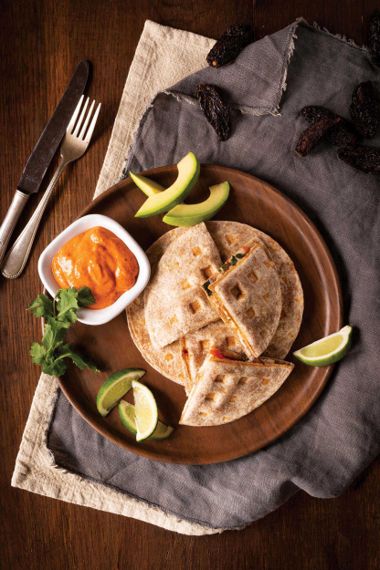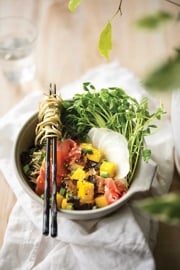Hot Stuff
If you’ve spent any time travelling around the globe, your burning lips have made you well aware of the way various guises of chili peppers have become a fixture of so many world cuisines.
A papaya salad from a Thailand street market or a fragrant curry dished out by a family restaurant in southern India wouldn’t be the same without their chili punch. Just imagine eating street tacos in Mexico if they didn’t induce a few drops of sweat. What we typically eat in North America is relatively tame in comparison.
Capable of turning the blandest soup or sauce into a palate-exploding triumph, cooking with chili peppers—from mild poblano to volcano-like habanero—will dial up the excitement of your dishes. Use them to accentuate both savoury and sweet ingredients.
You don’t have to be a heat freak to enjoy eating chili peppers since their “spice” levels vary greatly—enough to suit all tastes. Beyond their culinary virtues, research suggests that hot peppers may literally be the “spice of life” by improving the chances for healthy longevity.
It’s time to bring the heat into the kitchen, and let the table dares begin.

This brightly coloured soup for chili lovers is the perfect way to welcome back warmer weather. Looking for a little less heat? Substituting serrano pepper with jalapeno will make a slightly less spicy soup. Garnish options include pea shoots, hemp seeds, sesame seeds, sliced roasted almonds, chives, or a swirl of sour cream.

A good option for both backyard barbecues and healthy snacking, this creamy dip benefits from a little spicy crunch, courtesy of quick-pickled peppers. If you want your dip to have a smoky edge, blend in a chipotle-flavoured salsa. Or forgo the salsa and, instead, blend in a couple tablespoons of tomato paste and a single canned chipotle chili pepper. Extras of the pickled peppers are an exciting topping for burgers, sandwiches, and tacos.

This Mexican-Mediterranean hybrid dish gleans its tempered kick from parched ancho chilies, the dried form of poblano peppers known for their smoky quality and sweet to moderate heat. It’s a fantastic saucy, and comforting, appetizer or meal on its own. Serve with crusty bread to sop up every last bit of the red sauce, or spoon over cooked grain.

These Asian-inspired salmon burgers won’t leave you missing the beef or the bun. And keep this fruity and fiery salsa in mind the next time you want to jazz up grilled chicken or taco night. Serrano pepper or chile de arbol would be good swaps for bird’s eye pepper in the salsa. You can even mix some Sriracha sauce into the burgers to further punch up the meal.
Paging Dr. Pepper
For flaming hot health, go ahead and turn up the heat. A recent study from the American Heart Association found that people who eat chili peppers regularly may be 26 percent less likely to die of heart disease and 23 percent less likely to die of cancer than those who don’t.
While this investigation can’t prove cause and effect, nor did it nail down how many or which chili peppers lower the risk the most, it’s believed that capsaicin—the compound that gives chilies their fiery kick—can be good for our health by reducing inflammation and even bolstering metabolism. More research is needed, but if you like to spike your meals with chili peppers, you may reap some health and longevity rewards for doing so regularly.
Handle with care
When preparing chili peppers, if your fingers come into contact with the ribs or seeds (the hottest part of the pepper) and then sensitive areas such as your eyes, you’ll likely feel a very unpleasant burn that could bring you to tears. Very hot peppers can damage your eyes and burn the skin.
After slicing any hot peppers be sure to immediately wash your hands with hot, soapy water. You should also clean the knife and cutting board before proceeding with your recipe. To be safe, you can also wear a pair of gloves while handling chili peppers, especially those that rank very high on the heat scale, so the volatile oils will not get on your skin.
Contrary to popular belief, most of the capsaicin in chili peppers is found in their inner white membranes and not the seeds. So, if you want to moderate the heat of a pepper, be sure to strip the membrane and the seeds, though doing so may dial down the health benefits.
Cream of the crop
In general, select peppers that are firm, have vibrant, shiny skin, and feel heavy for their size. Try to avoid peppers that are limp or shrivelled and have soft spots or bruises. When the good ones are brought home, they should last in your fridge when stored in a paper or cloth bag for at least two weeks.
Dynamic duo
Heat intensifies the flavour of sweet ingredients, while sugars tend to tame “spicy” ingredients and highlight their fruity notes. This is why delicious results always come when you spike chocolate cake or pudding with a hit of chili pepper.







